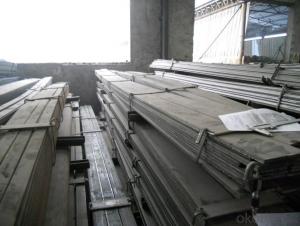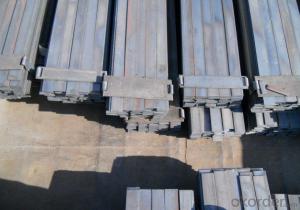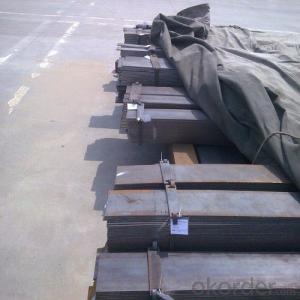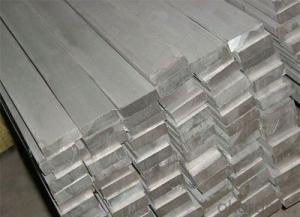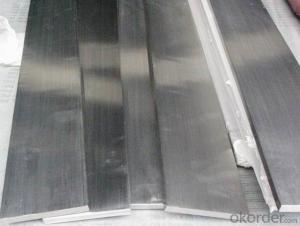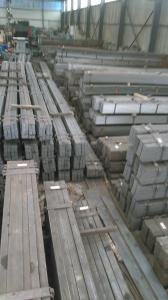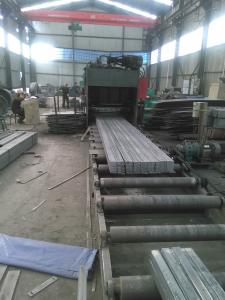Low Carbon Steel Flat Iron bars in High Quality
- Loading Port:
- China Main Port
- Payment Terms:
- TT or LC
- Min Order Qty:
- 100 m.t.
- Supply Capability:
- 10000 m.t./month
OKorder Service Pledge
OKorder Financial Service
You Might Also Like
OKorder is offering Low Carbon Steel Flat Iron bars in High Quality at great prices with worldwide shipping. Our supplier is a world-class manufacturer of steel, with our products utilized the world over. OKorder annually supplies products to African, South American and Asian markets. We provide quotations within 24 hours of receiving an inquiry and guarantee competitive prices.
Product Applications:
Low Carbon Steel Flat Iron bars in High Quality are ideal for structural applications and are widely used in the construction of buildings and bridges, and the manufacturing, petrochemical, and transportation industries.
Product Advantages:
OKorder's Low Carbon Steel Flat Iron bars in High Quality are durable, strong, and wide variety of sizes.
Main Product Features:
· Premium quality
· Prompt delivery & seaworthy packing (30 days after receiving deposit)
· Can be recycled and reused
· Mill test certification
· Professional Service
· Competitive pricing
Product Specifications:
Manufacture: slited
Slitting precision (width) : 0.5 mm or less
Raw material: Q235B, Q345B, Q235-1 b
crosscutting precision (length) : 2 mm or less
Processing: the thickness of 2.0-16 mm;
Shear length: 2000 mm above
Wide degree: 15-1250 - mm;
Leveling precision: 1-2 MM square
Packaging: Export packing, nude packing, bundled
FAQ:
Q1: Why buy Materials & Equipment from OKorder.com?
A1: All products offered byOKorder.com are carefully selected from China's most reliable manufacturing enterprises. Through its ISO certifications, OKorder.com adheres to the highest standards and a commitment to supply chain safety and customer satisfaction.
Q2: How do we guarantee the quality of our products?
A2: We have established an advanced quality management system which conducts strict quality tests at every step, from raw materials to the final product. At the same time, we provide extensive follow-up service assurances as required.
Q3: How soon can we receive the product after purchase?
A3: Within three days of placing an order, we will arrange production. The normal sizes with the normal grade can be produced within one month. The specific shipping date is dependent upon international and government factors, the delivery to international main port about 45-60days.
Images:
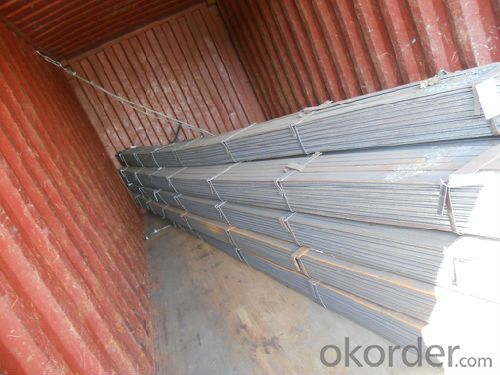
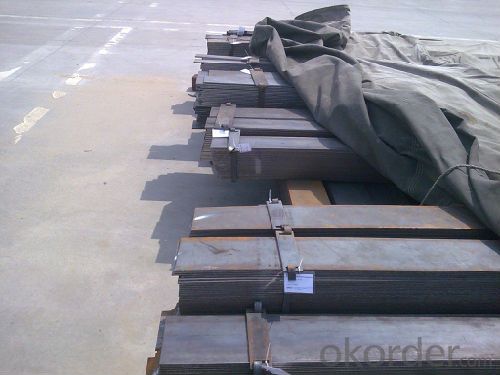
- Q:Can steel flat bars be used for agricultural applications?
- Yes, steel flat bars can be used for agricultural applications. Steel is known for its strength and durability, making it suitable for various agricultural tasks. Steel flat bars can be used for constructing fences, gates, and livestock enclosures, providing a sturdy and long-lasting solution. They can also be used as support beams or braces for structures like barns or sheds. Additionally, steel flat bars can be used for creating custom implements or machinery parts, such as plow blades or cultivator tines. Overall, steel flat bars offer the necessary strength and versatility required for agricultural applications.
- Q:Can steel flat bars be bent without cracking?
- Yes, steel flat bars can be bent without cracking, depending on their composition, thickness, and the bending process used. Steel is a highly malleable material, meaning it can be bent or shaped without breaking. However, it is important to note that the extent to which steel bars can be bent without cracking varies based on several factors. The composition of the steel is crucial in determining its flexibility and resistance to cracking. Different grades of steel have varying levels of ductility, with more ductile steels being better suited for bending without cracking. For instance, mild steel is known for its excellent ductility and is commonly used for bending operations without issues. The thickness of the steel bar also plays a role in its ability to withstand bending without cracking. Thinner bars are generally more prone to cracking, especially if the bending radius is too small. It is important to ensure that the bending process corresponds to the thickness of the steel bar to prevent cracking. The bending process itself is crucial in avoiding cracking. Generally, steel flat bars can be bent using different techniques such as cold bending or hot bending. Cold bending is typically performed at room temperature and involves slowly applying force to the bar until it reaches the desired shape. Hot bending, on the other hand, involves heating the steel bar to a specific temperature range before bending. The heat reduces the risk of cracking by increasing the material's ductility. Applying gradual and even pressure during the bending process is crucial to avoid cracking. Sharp or sudden bends can create stress concentrations, increasing the likelihood of cracking. It is recommended to use appropriate tools, such as bending machines or specialized dies, to ensure a controlled and uniform bending process. In summary, steel flat bars can be bent without cracking if the steel composition is suitable, the thickness is appropriate, and the bending process is carefully executed. It is always advisable to consult with experts or refer to specific guidelines and standards to ensure a successful and crack-free bending operation.
- Q:What are the different specifications for steel flat bars?
- Steel flat bars are available in a variety of specifications that determine their size, shape, and composition. These specifications encompass dimensions, such as width, thickness, and length, as well as the type of steel utilized and any additional properties. Dimensions for steel flat bars exhibit considerable variation. Widths commonly range from 1/2 inch to 12 inches, while thicknesses can span from 1/8 inch to several inches. Lengths are typically denoted in feet or meters, with standard lengths, such as 6 or 12 feet, readily accessible, or customized lengths tailored to the desired dimensions. The type of steel employed in flat bars also displays diversity. Carbon steel, a fundamental and versatile choice, and stainless steel, which offers resistance against corrosion and presents an appealing aesthetic, are the most prevalent types. Carbon steel flat bars are further categorized based on their carbon content, with low-carbon, medium-carbon, and high-carbon steel constituting widely available options. Moreover, steel flat bars can possess supplementary properties based on their intended utilization. For instance, certain flat bars may undergo heat treatment to augment their strength or hardness, while others may undergo galvanization or coating to heighten their resistance to corrosion. It is important to note that different countries and industries may adhere to their own distinct standards or specifications for steel flat bars. These standards, such as ASTM (American Society for Testing and Materials) or EN (European Norms), ensure consistency and quality across various manufacturers and applications. Consequently, it is crucial to consider these standards and specifications when selecting steel flat bars for a specific project or application.
- Q:Are steel flat bars suitable for welding fixtures?
- Indeed, welding fixtures find steel flat bars to be a suitable choice. The reason lies in the fact that steel flat bars are frequently employed in welding fixtures owing to their ability to provide substantial strength and durability. Consequently, they are considered ideal for applications demanding stability and support. Moreover, steel flat bars can be effortlessly welded, enabling the creation of fixtures that are both stable and dependable. The flat surface of these bars serves as a solid foundation for welding operations, guaranteeing precise alignment throughout the welding procedure. All in all, due to their strength, weldability, and stability, steel flat bars are widely favored when it comes to welding fixtures.
- Q:How do steel flat bars compare to other materials like concrete or glass?
- Steel flat bars have several advantages over other materials like concrete or glass. Firstly, steel flat bars are extremely strong and durable. They have a high tensile strength, which means they can withstand heavy loads and resist deformation. In comparison, concrete is strong in compression but weak in tension, whereas glass is brittle and prone to breaking. Steel flat bars are a much more reliable and long-lasting option when it comes to structural applications. Secondly, steel flat bars offer versatility in terms of design and construction. They can be easily fabricated into various shapes and sizes, making them suitable for a wide range of applications. Concrete, on the other hand, requires complex formwork and curing processes, while glass often has limitations in terms of size and shape. Steel flat bars provide greater flexibility in design and can be easily modified or adjusted if needed. Additionally, steel flat bars have excellent thermal conductivity, which makes them ideal for applications where heat transfer is important. Concrete and glass, on the other hand, have lower thermal conductivity and are not as efficient in transferring heat. This makes steel flat bars a preferred choice for applications such as heat exchangers or structural components in buildings where temperature control is crucial. Moreover, steel flat bars have a higher resistance to fire compared to concrete or glass. They can withstand high temperatures for a longer period without losing their structural integrity. Concrete tends to crack and spall under extreme heat, while glass can shatter or melt. Steel flat bars provide superior fire resistance, making them a safer choice in applications where fire protection is a concern. In conclusion, steel flat bars offer numerous advantages over materials like concrete or glass. They are stronger, more versatile, have better thermal conductivity, and higher resistance to fire. These qualities make steel flat bars a preferred choice for various applications, ranging from structural construction to industrial equipment.
- Q:What are the standard tolerances for straightness in steel flat bars?
- The standard tolerances for straightness in steel flat bars vary depending on the specific industry and application. However, in general, the common tolerance range for straightness in steel flat bars is typically within 0.25% to 0.5% of the total length of the bar.
- Q:How do steel flat bars contribute to the energy efficiency of buildings?
- There are several ways in which steel flat bars can enhance the energy efficiency of buildings. Firstly, steel is an extremely durable material that can withstand harsh weather conditions, such as strong winds and heavy rain. This durability ensures that the building's structural integrity is maintained over time, resulting in a longer lifespan and reducing the need for frequent repairs or replacements. As a result, energy and cost savings are achieved. Moreover, steel flat bars are commonly used in the construction of windows and doors, which play a vital role in the energy efficiency of a building. These components help minimize heat transfer and air leakage. When steel is used in window or door frames, its poor heat conductivity provides excellent insulation properties. This insulation prevents heat loss during cold winters and heat gain during hot summers, thereby reducing reliance on heating and cooling systems and improving energy efficiency. Additionally, steel flat bars can serve as structural elements in the building's envelope, such as wall framing or roof trusses. Utilizing steel in these applications allows for the creation of lighter and stronger structures. This, in turn, enables the incorporation of larger windows and open floor plans, promoting natural daylighting and ventilation. By maximizing the utilization of natural resources, steel flat bars contribute to the overall energy efficiency of the building, reducing the need for artificial lighting and mechanical ventilation systems. Finally, steel is a recyclable material, which means that it can be easily recycled and repurposed for other applications after its use in a building. This fosters sustainable construction practices and diminishes the overall environmental impact of the building industry. By selecting steel flat bars for construction, builders contribute to a circular economy, where materials are reused rather than discarded, thus further enhancing the energy efficiency and sustainability of the building. In conclusion, the utilization of steel flat bars enhances the energy efficiency of buildings through their durability, insulation properties, structural advantages, and recyclability. By incorporating steel in various building components, builders can create more sustainable and energy-efficient structures, resulting in long-term cost savings and reduced environmental impact.
- Q:What are the different certifications and standards for steel flat bars?
- There are several certifications and standards that apply to steel flat bars, ensuring their quality and suitability for various applications. Some of the most common certifications and standards include: 1. ASTM International (formerly known as the American Society for Testing and Materials): ASTM A108 is a standard specification for steel bars, carbon and alloy, cold-finished, while ASTM A36 is a standard specification for carbon structural steel that covers carbon steel shapes, plates, and bars of structural quality. 2. American Iron and Steel Institute (AISI): AISI 1018 is a common low carbon steel grade that is often used in steel flat bars. This grade conforms to AISI standards and is known for its excellent weldability and machinability. 3. Society of Automotive Engineers (SAE): SAE 4140 is a high-strength steel alloy commonly used in steel flat bars. It meets the SAE J404 standard, which specifies chemical composition limits for carbon and alloy steel bars. 4. European Norms (EN): EN 10025-2 is a standard specification for hot-rolled products of structural steels, including steel flat bars, that specifies technical delivery conditions for non-alloy structural steels. 5. International Organization for Standardization (ISO): ISO 683-3 is a standard that specifies the technical delivery requirements for steel bars, hot-rolled or forged, in various grades and conditions. 6. British Standards (BS): BS EN 10025-2 is a British standard that aligns with the European Norms and specifies the technical delivery conditions for non-alloy structural steels, including steel flat bars. It is important to note that specific applications may require additional certifications or standards. For example, steel flat bars used in construction may need to meet specific building codes or regulations set by local authorities. Additionally, industries such as aerospace or automotive may have their own unique certifications or standards to ensure the performance and safety of steel flat bars used in their applications.
- Q:Can steel flat bars be used in the manufacturing of material handling equipment?
- Certainly, material handling equipment can definitely incorporate steel flat bars. These bars, commonly produced from carbon steel, are renowned for their robustness, endurance, and adaptability. These attributes render them highly suitable for a multitude of applications within material handling equipment, including the construction of frames, supports, brackets, and other foundational components. Steel flat bars can be effortlessly welded, cut, and shaped into various forms and dimensions, enabling customization and versatility throughout the manufacturing process. Moreover, they possess exceptional load-bearing capabilities, making them well-suited for managing hefty loads and ensuring stability and dependability in material handling equipment. All in all, owing to their strength, durability, and ability to meet the exacting demands of such equipment, steel flat bars are a favored choice in material handling equipment manufacturing.
- Q:Can steel flat bars be painted?
- Yes, steel flat bars can be painted. Before painting, it is important to properly prepare the surface by cleaning it thoroughly to remove any dirt, grease, or rust. If there is rust present, it should be removed using sandpaper or a wire brush. Once the surface is clean and smooth, a suitable primer should be applied to ensure good adhesion of the paint. After the primer has dried, a coat or multiple coats of paint can be applied using a paintbrush, roller, or spray paint. It is recommended to use a paint specifically designed for metal surfaces to ensure durability and longevity of the paint job.
1. Manufacturer Overview |
|
|---|---|
| Location | |
| Year Established | |
| Annual Output Value | |
| Main Markets | |
| Company Certifications | |
2. Manufacturer Certificates |
|
|---|---|
| a) Certification Name | |
| Range | |
| Reference | |
| Validity Period | |
3. Manufacturer Capability |
|
|---|---|
| a)Trade Capacity | |
| Nearest Port | |
| Export Percentage | |
| No.of Employees in Trade Department | |
| Language Spoken: | |
| b)Factory Information | |
| Factory Size: | |
| No. of Production Lines | |
| Contract Manufacturing | |
| Product Price Range | |
Send your message to us
Low Carbon Steel Flat Iron bars in High Quality
- Loading Port:
- China Main Port
- Payment Terms:
- TT or LC
- Min Order Qty:
- 100 m.t.
- Supply Capability:
- 10000 m.t./month
OKorder Service Pledge
OKorder Financial Service
Similar products
New products
Hot products
Hot Searches
Related keywords









